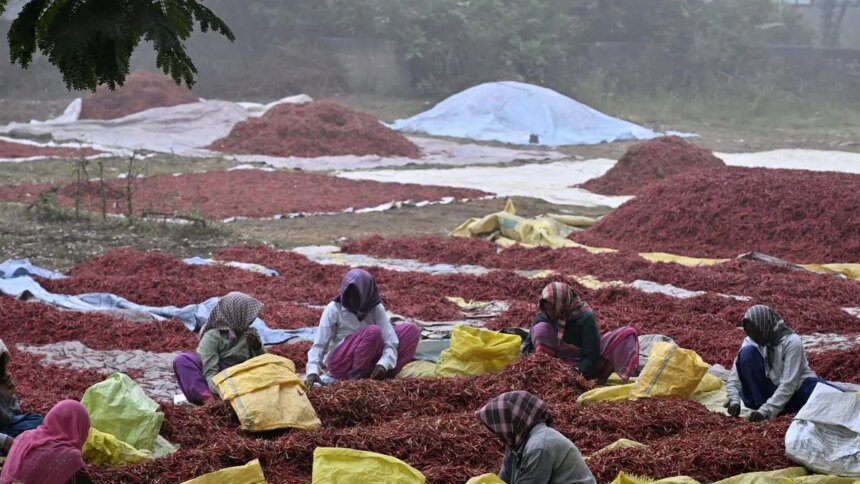India’s chilli acreage is projected to have declined by 30-40% this kharif season, attributed to last year’s low prices that prompted farmers to shift to other crops such as maize, cotton, and tobacco in key producing states of Andhra Pradesh, Telangana, and Karnataka, according to industry stakeholders. The reduction in planting area, combined with an expected delay in new crop arrivals, has led to a rebound in prices of dry red chillies in recent days.
“The overall area is down by around 40% as farmers were reluctant to plant the chilli crop this year due to losses incurred last year. In Andhra and Telangana, the acreage has decreased by 40% each, while Karnataka has seen a 50% drop. Additionally, excessive rainfall in some regions has necessitated replanting,” stated Sambasiva Rao Velagapudi, President of the Chilli Exporters Association in Guntur.
Sandeep Voddepalli, general manager at BigHaat Agro Pvt Ltd, which sources dry chillies for numerous companies, estimates a 30-35% decrease in acreage. Including losses from recent heavy rains affecting about 5-7% of the area, he predicts a total decrease of around 40%.
The contraction in acreage spans across the five major chilli-growing states: Madhya Pradesh, Maharashtra, Andhra Pradesh, Telangana, and Karnataka. For instance, the area designated for colouring chilli varieties like Byadgi, Dabbi, and 5531 has also seen considerable reductions, particularly with Byadgi chilli cultivation down by approximately 50% in Karnataka. Voddepalli noted that Madhya Pradesh’s chilli area has declined by about 30%.
Basavaraj Hampali of Hampali Traders in Hubballi reported that Karnataka has experienced more than a 25% drop in chilli acreage. In regions like Kundagol and Annigeri, which are significant producers of Byadgi chillies, recent heavy rains have caused crop losses; however, the crop appears healthy in the Ballari region.
Prices for dry chillies have started to increase from last week due to the reduced acreage and a projected delay in crop arrivals of about 25 days. Voddepalli noted that the demand for cold storage chillies is likely to rise. Average prices have surged by roughly 15% from July-August levels, which were around Rs 130-135 per kg.
“Prices are expected to remain stable and show a firm trend due to the delayed new crop arrivals,” Velagapudi remarked. The stocks of dry chillies in cold storage are estimated at about 1.5 crore bags, roughly equivalent to last year’s figures, although new arrivals are delayed by over a month, with expectations set for around January 20.
In the past two months, prices have risen by about Rs 30 per kg for local consumption varieties such as 5531, 341, and 334. However, the Teja variety has only seen an increase of Rs 10 per kg due to lower export demand, according to Velagapudi.
China, the largest buyer of Indian chillies, has already increased its purchases, acquiring approximately 5,000 more containers than the previous year. “China has sufficient stock and is not looking to buy more, which has impacted the Teja variety negatively,” Velagapudi added.
According to data from the Spices Board, India’s red chilli production for the 2024-25 season is expected to be lower at 26.93 lakh tonnes, harvested from 9.21 lakh hectares, compared to 29.09 lakh tonnes from 9.65 lakh hectares the previous year.
Published on October 10, 2025.










